Red Persia. Part of 1. How the Gilan Soviet Republic appeared in the South Caspian
The struggle for the constitution and the crisis of power Qajar dynasty
The revolutionary events in Iran began the twentieth century. were caused by a significant discrepancy between the socio-economic needs of the country and the specifics of the political organization of the Iranian state. By the beginning of the twentieth century. In Persia, the Qajar dynasty was in power for more than a century. It came to power in 1796 and was one of the noble clans of the Azerbaijani-Turkmen Kadjar tribe that inhabited Khorasan and Asterabad. Representatives of the Asterabad Kajar came to power in Persia. In general, the Qadjar dynasty was a ruling surname of Turkic origin quite common in the Persian history of the New Age. Her coming to power was quite natural, since it was the Kadjars who were considered the support of the Turkic Safavid dynasty, which ruled the Persian state for several centuries. However, by the beginning of the twentieth century. The political system has largely outlived itself, especially against the background of the growing expansion of foreign capital into the Iranian economy, especially Russian and British. In an effort to retain power, the Qajars, on the one hand, preserved the feudal system in Persia, with the result that the country was characterized by a low efficiency of the management system, and on the other hand, they gradually gave the country’s resources to foreign owners.
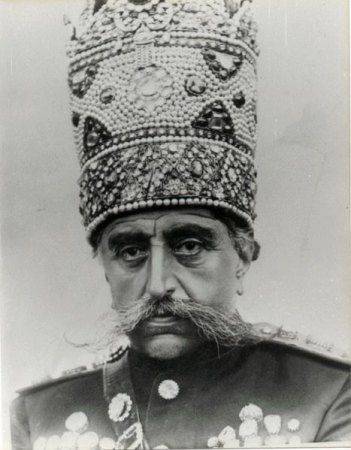 The internal contradictions were growing in the country, which were aggravated by the discontent of the urban strata by the policies of the government of Shah Mozaferdine (see photo). The formal reason for the performance of the urban population was the sentence imposed on a group of Tehran merchants. Governor-General of Tehran Ala al-Doule ordered to beat the merchants with heels on his heels for raising the price of imported sugar. This happened on December 12 1905, and at the beginning of 1906, mass unrest began in Tehran. The rebellious Tehranians demanded the resignation of Sadrazam Ain al-Dowle - the head of the Shah government, and then there were demands for the adoption of a constitution and the creation of a parliament - the Majlis.
The internal contradictions were growing in the country, which were aggravated by the discontent of the urban strata by the policies of the government of Shah Mozaferdine (see photo). The formal reason for the performance of the urban population was the sentence imposed on a group of Tehran merchants. Governor-General of Tehran Ala al-Doule ordered to beat the merchants with heels on his heels for raising the price of imported sugar. This happened on December 12 1905, and at the beginning of 1906, mass unrest began in Tehran. The rebellious Tehranians demanded the resignation of Sadrazam Ain al-Dowle - the head of the Shah government, and then there were demands for the adoption of a constitution and the creation of a parliament - the Majlis. Mozaferreddin Shah Qajar was forced to create the Majlis and introduce the right to vote for men older than 25 years, corresponding to the necessary property qualifications. In September, 1906 was established in Tehran, an elected body - angemen, which took over the functions of legislative and judicial power. However, the Shah was in no hurry to sign the draft constitution, developed in the Majlis. The fact is that Mozaferdin-Shah was mortally ill and his inner circle waited for his imminent death, to the Persian throne of his eldest son Mohammed-Ali Mirza, known for his ultra-conservative convictions and former opponent of the constitution. It is noteworthy that the closest adviser and tutor of Mohammed-Ali Mirza was a Russian diplomat and orientalist Sergey Markovich (Gray Mordekhaevich) Shapshal (1871-1963) - punished by nationality, known for his conservative views. It turns out that the Russian influence was felt by both sides of the Persian political confrontation - both constitutional revolutionaries and supporters of the conservation of the Shah’s absolute power. Nevertheless, Shah Mozaferdin managed to sign the first part of the constitution, which gives the Mejlis significant rights in the field of financial management, roads, the establishment of state borders. However, 1 January 1907 Shah passed away. A week later, Muhammad Ali Shah Qajar took the throne, who decided to disperse the Majlis.
Rise of Sattar Khan
An uprising broke out in Tabriz, as a result of which the governor and officials were arrested and government buildings seized. In the cities of Persia, angemen began to appear - elected bodies, trade unions were created. Revolutionary speeches reached their greatest scope in Iranian Azerbaijan and in the province of Gilan, located on the southern coast of the Caspian Sea. This was explained by the fact that Gilan and Azerbaijan were in close proximity to the Russian Transcaucasus, where during these years the revolutionary movement was also gaining momentum, covering a wide section of the Armenian, Georgian, Azerbaijani, Russian population. In Iranian Azerbaijan and Gilan, detachments of Mujahideen from the number of urban artisans, small traders, a small working class were created. 22 June 1908 Shah Mohammed Ali Qajar imposed a state of emergency in the capital. Government forces bombarded the mosque of Sepekhsalar with artillery shells, where there were supporters of the constitution, and later the police arrested leading leaders of the constitutionalists, some of whom were executed. The Mejlis was officially dissolved - as reported by the government, at the time of stabilization of the political situation in the country. However, these actions of the Shah caused an uprising in the territory of Iranian Azerbaijan, which was headed by Sattar Khan (1868-1914) - a native of the Karadag village in Iranian Azerbaijan, the son of a small cloth merchant.
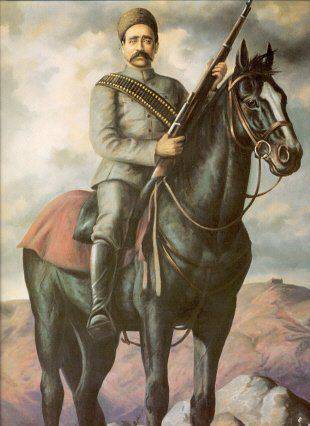 From a young age, Sattar Khan (in the photo) participated in the opposition movement, hiding from arrest among the nomadic Shahseven tribes of Iranian Azerbaijan. For about twelve years, Sattar earned his living literally “on the high road” - he robbed the trade caravans, but then the former robber hired as a road guard. So Sattar turned from a robber into a professional guard, but he did not lose his hatred for the Shah's regime. When in 1907-1908 unrest began in Iranian Azerbaijan, caused by the suppression of constitutionalists, Sattar Khan led his own unit of the Fedains. At the head of the detachment, he participated in military clashes on the territory of Tabriz, capturing an entire area of the city - Amirhiz, where Sattar managed to repel the attacks of the Shah's troops for several months. While Sattar was operating in Tabriz, representatives of the Transcaucasian revolutionary movement came in contact with him, including Mashadi Azizbekov (1876-1918) - an Azerbaijani revolutionary, a Social Democrat, who was later executed among the legendary 26 of Baku commissars.
From a young age, Sattar Khan (in the photo) participated in the opposition movement, hiding from arrest among the nomadic Shahseven tribes of Iranian Azerbaijan. For about twelve years, Sattar earned his living literally “on the high road” - he robbed the trade caravans, but then the former robber hired as a road guard. So Sattar turned from a robber into a professional guard, but he did not lose his hatred for the Shah's regime. When in 1907-1908 unrest began in Iranian Azerbaijan, caused by the suppression of constitutionalists, Sattar Khan led his own unit of the Fedains. At the head of the detachment, he participated in military clashes on the territory of Tabriz, capturing an entire area of the city - Amirhiz, where Sattar managed to repel the attacks of the Shah's troops for several months. While Sattar was operating in Tabriz, representatives of the Transcaucasian revolutionary movement came in contact with him, including Mashadi Azizbekov (1876-1918) - an Azerbaijani revolutionary, a Social Democrat, who was later executed among the legendary 26 of Baku commissars. From Baku to Tabriz rushed transports with weapons and even volunteers from among the Caucasian revolutionaries.
The Russian embassy in Persia reported to St. Petersburg that Sattar Khan's troops receive serious help from the Caucasian revolutionaries and without it they could hardly survive for such a long time. It is known that Sattar Khan's personal security consisted of Dagestanis and consisted of 250 people, and the Russian sailor TAA commanded the artillery units of Sattar Khan. Goncharovsky nicknamed "Alyosha" - a former sailor of the battleship "Potemkin", who turned out to be on Persian soil. The Shah's troops did not manage to take Sattar Tabriz captured by the troops. However, the confusion in Iranian Azerbaijan led to a worsening of the criminal situation. Thus, in the vicinity of Ardabil, nomads from the Shahsevens tribe began to attack and rob local residents, who were considered subjects of the Russian Empire. Petersburg used these cases as a formal pretext for sending troops to Persia. 20 April 1909 The commander of the Caucasian District, Adjutant General Illarion Vorontsov-Dashkov, received an order from the emperor to advance Russian army units to Tabriz to protect the subjects of the Russian Empire. The expeditionary forces included two battalions of the 1 Caucasian Rifle Brigade, four horseback hundreds of Kuban Cossacks, a sapper company and three artillery batteries. Commander was appointed Major General I.A. Snarsky, who commanded the 1-th Caucasian Rifle Brigade. The Russian troops were able to bring relative order to Iranian Azerbaijan in a fairly short time, having “calmed down” the nomadic tribes of Kurds and Turkmen Yomuds, who were harassing the sedentary population with constant looting. When the Russian troops entered Tabriz, the city was forced to leave and the troops of Sattar Khan. The rebel leader himself took refuge in the Turkish embassy.
However, by this time the uprising began in a number of other cities in the country. Moreover, the militant Bakhtiar tribes also opposed the Shah's government. The Iranian-speaking nomadic and semi-nomadic Bakhtiar tribes live in Southwestern Iran, in the provinces (stop) Isfahan and Chekharmekhal and Bakhtiariya. Ethnically and culturally, they are close to neighboring Kurds and Lurs. For several centuries of Iranian history, the Bakhtiari played an important role in it, the benefit being numerous and belligerent. In the 19th century, English agents established strong contacts with the Bakhtiari, who gradually turned the tribes of Southwestern Iran into an instrument of their influence. In particular, in 1897, they participated in the suppression of the anti-British national uprising in the city of Shushtera, in the southern province of Khuzestan.
Suppression of the "Constitutional Revolution"
In May, 1909 from Gilan in the direction of Tehran moved the units of the Fedain, with Isfahan, in turn, came out the formation of Bakhtiar numbering about a thousand fighters. 30 June 1909 The units of the Fedayin and Bakhtiar entered Tehran and captured the building of the Majlis.
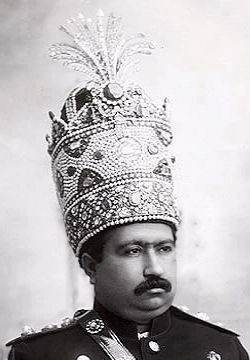 Shah Mohammed-Ali Qajar (pictured) was overthrown and hid on the territory of the Russian representative office, and his son Sultan Ahmad Shah (1898-1930), who was only eleven years old, was proclaimed new Shah of Persia. The constitution was restored in the country. A directory of 20 people was created to control Persia, and on November 2 a second Majlis was opened on 1909 in November. Seeking to improve the economic situation of the country, the directory entered into negotiations with the American leadership. The United States, which was rapidly expanding its influence in the world, was also interested in an economic presence in Persia. In April, 1911 arrived in Persia by a group of American economic advisers led by Morgan Schuster, who actually received complete freedom of action in terms of determining the country's financial and economic policy. Under pressure from Schuster, the Persian government continued the practice of foreign loans, primarily from the United States, and introduced new taxes. Schuster set about creating a military force under his control — a financial gendarmerie of up to 15 thousand of gendarmes and officers. Naturally, the policy of the American adviser, which consisted in taking a number of measures unpopular with the people, caused growing discontent of the Persian population. In turn, Shah Mohammed-Ali Qajar, who managed to leave Persia and move to Russia, in July 1911 enlisted the support of the Turkmen tribal leaders and tried to take revenge in order to regain power. Detachments loyal to the former Shah, captured Astrabad. However, government forces managed to defeat the Turkmen forces of the former Shah, and Mohammed Ali returned to Russia. He settled in Odessa, where he lived before the revolution, and then emigrated to Istanbul and, later, to Italy, where he lived the rest of his days.
Shah Mohammed-Ali Qajar (pictured) was overthrown and hid on the territory of the Russian representative office, and his son Sultan Ahmad Shah (1898-1930), who was only eleven years old, was proclaimed new Shah of Persia. The constitution was restored in the country. A directory of 20 people was created to control Persia, and on November 2 a second Majlis was opened on 1909 in November. Seeking to improve the economic situation of the country, the directory entered into negotiations with the American leadership. The United States, which was rapidly expanding its influence in the world, was also interested in an economic presence in Persia. In April, 1911 arrived in Persia by a group of American economic advisers led by Morgan Schuster, who actually received complete freedom of action in terms of determining the country's financial and economic policy. Under pressure from Schuster, the Persian government continued the practice of foreign loans, primarily from the United States, and introduced new taxes. Schuster set about creating a military force under his control — a financial gendarmerie of up to 15 thousand of gendarmes and officers. Naturally, the policy of the American adviser, which consisted in taking a number of measures unpopular with the people, caused growing discontent of the Persian population. In turn, Shah Mohammed-Ali Qajar, who managed to leave Persia and move to Russia, in July 1911 enlisted the support of the Turkmen tribal leaders and tried to take revenge in order to regain power. Detachments loyal to the former Shah, captured Astrabad. However, government forces managed to defeat the Turkmen forces of the former Shah, and Mohammed Ali returned to Russia. He settled in Odessa, where he lived before the revolution, and then emigrated to Istanbul and, later, to Italy, where he lived the rest of his days. Both Russian and British ruling circles were concerned about the events in Persia. Russia and Great Britain have long been preparing the actual division of Persia into spheres of influence. The northern regions before Isfahan, Yazd and Zulfagar were to enter the sphere of influence of the Russian Empire, and the southern regions were of interest to Great Britain. The Russian government was concerned about the growth of revolutionary sentiment in Persia and the overthrow of the Shah, but even more so to the Russians and the British were concerned about the penetration of American capital into the country and the activities of American advisers. 16 November 1911 The Russian Empire demanded that the Persian government immediately dismiss Morgan Schuster and abandon the practice of hiring foreign specialists without consulting with Russia and the United Kingdom. Russian troops entered the territory of Iranian Azerbaijan, suppressing revolutionary demonstrations in Tabriz and Gilan. In March 1912, the government of Persia agreed with the demands of Great Britain and the Russian Empire. However, the activities of the Persian government and, especially, the division of the country into spheres of influence of the Russian Empire and Britain, did not satisfy the interests of the Persian population, who felt the “taste of revolution”. Particularly strong opposition sentiment persisted in Gilan province. A powerful “Janghelian movement” was formed here (from the word “jengel” - a forest). The Gilan “forest brothers” armed themselves and carried out small raids on government institutions. Representatives of the most diverse social groups — peasants, merchants, workers, artisans, and intellectuals — participated in the jangelian movement. Ethnically, the Gilians (the Iranian-speaking Persian people inhabiting the Gilan province) and the Talysh (also the Iranian-speaking people living next to the Gilians in Iran and in Azerbaijan) prevailed. The revolution in neighboring Russia had a tremendous impact on the insurgency in Gilan.
Tabriz uprising of Sheikh Hiabani
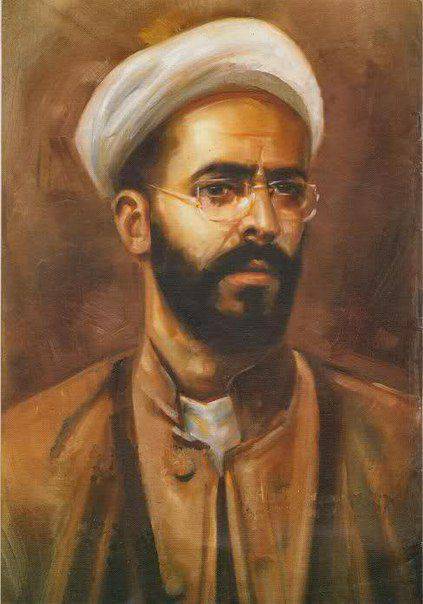 In April, 1920 in Northern Iran began a powerful anti-government uprising, led by the famous revolutionary Sheikh Mohammad Khiabani (1880-1920). A native of the village of Khamene in the outskirts of Tabriz, Mohammad was the son of a local merchant Haji Abdul Hamid and in his youth helped his father in his business affairs, including in Russia - in Petrovsk (now Makhachkala). Then Mohammad retired from trading activities and, after receiving a religious education in Tabriz, got a job as an astronomy teacher at the Tabriz madrasa Talibiye. Adhering to progressive views, he participated in the uprising of 1908-1909. in Tabriz and, after street fighting in the Tabriz district of Khiabani, received an addition to his name - Mohammad Khiabani. In 1909, Mr. Khiabani joined the Iranian Democratic Party, but after the defeat of the revolution, he was forced to leave Persia and move to Russia - first to Petrovsk, and then to Vladikavkaz. The politician returned to Persia only in 1914, heading the provincial committee of the Iranian Democratic Party in Tabriz. After the revolution in Russia, Khiabani, greeting him, understood that it was time to act. In 1917, he became one of the leaders of the Azerbaijan Democratic Party (ADP) split from the FDP. The party proclaimed its goal of fighting foreign influence in the country and the overthrow of the government of Vosuga od Doule, who conducted pro-British policies. When the Turkish troops invaded Iranian Azerbaijan in the summer of 1918, a detachment of 500 people under the command of Khiabani resisted the Turkish army that captured Tabriz. However, Khiabani and his associates Mirza Ismail Noubari and Haji Mammadli Badamchi were arrested and deported to Kars. Only in 1919, the city of Khiabani returned to Tabriz and began preparations for the uprising. 6 April 1920. The Azerbaijan Democratic Party raised a rebellion in Tabriz. Mohammad Khiabani gathered an 20-thousandth rally, which officially announced the start of an uprising against the Persian government. Soon, the most important cities of Iranian Azerbaijan, including Tabriz, Khoy and Ardabil, came under the control of the rebel army. At the conference of the Azerbaijan Democratic Party, Iranian Azerbaijan was renamed Azadistan, the “Country of Freedom,” and Mohammad Khiabani headed the national government. Under the leadership of the Khiabani government, social and democratic reforms began. Among them should be listed the most important ones: the introduction of free schooling in the Azerbaijani language, the reduction of food prices and the establishment of fixed prices for rice, sugar, kerosene, the creation of a free women's school, a hospital for 200 beds, an educational home for street children, a home for the disabled and the elderly.
In April, 1920 in Northern Iran began a powerful anti-government uprising, led by the famous revolutionary Sheikh Mohammad Khiabani (1880-1920). A native of the village of Khamene in the outskirts of Tabriz, Mohammad was the son of a local merchant Haji Abdul Hamid and in his youth helped his father in his business affairs, including in Russia - in Petrovsk (now Makhachkala). Then Mohammad retired from trading activities and, after receiving a religious education in Tabriz, got a job as an astronomy teacher at the Tabriz madrasa Talibiye. Adhering to progressive views, he participated in the uprising of 1908-1909. in Tabriz and, after street fighting in the Tabriz district of Khiabani, received an addition to his name - Mohammad Khiabani. In 1909, Mr. Khiabani joined the Iranian Democratic Party, but after the defeat of the revolution, he was forced to leave Persia and move to Russia - first to Petrovsk, and then to Vladikavkaz. The politician returned to Persia only in 1914, heading the provincial committee of the Iranian Democratic Party in Tabriz. After the revolution in Russia, Khiabani, greeting him, understood that it was time to act. In 1917, he became one of the leaders of the Azerbaijan Democratic Party (ADP) split from the FDP. The party proclaimed its goal of fighting foreign influence in the country and the overthrow of the government of Vosuga od Doule, who conducted pro-British policies. When the Turkish troops invaded Iranian Azerbaijan in the summer of 1918, a detachment of 500 people under the command of Khiabani resisted the Turkish army that captured Tabriz. However, Khiabani and his associates Mirza Ismail Noubari and Haji Mammadli Badamchi were arrested and deported to Kars. Only in 1919, the city of Khiabani returned to Tabriz and began preparations for the uprising. 6 April 1920. The Azerbaijan Democratic Party raised a rebellion in Tabriz. Mohammad Khiabani gathered an 20-thousandth rally, which officially announced the start of an uprising against the Persian government. Soon, the most important cities of Iranian Azerbaijan, including Tabriz, Khoy and Ardabil, came under the control of the rebel army. At the conference of the Azerbaijan Democratic Party, Iranian Azerbaijan was renamed Azadistan, the “Country of Freedom,” and Mohammad Khiabani headed the national government. Under the leadership of the Khiabani government, social and democratic reforms began. Among them should be listed the most important ones: the introduction of free schooling in the Azerbaijani language, the reduction of food prices and the establishment of fixed prices for rice, sugar, kerosene, the creation of a free women's school, a hospital for 200 beds, an educational home for street children, a home for the disabled and the elderly. 25 June 1920 Shah, worried about the events in Azerbaijan, fired the government of Vosuga od-Doule. However, Khiabani was no longer satisfied only with the resignation of the prime minister - he supported radical changes in the political structure of the country. Then appointed by the Governor-General of Tabriz Mohber os-Soltan began to organize the suppression of the uprising. He enlisted the support of the Iranian Cossack division stationed in the vicinity of the city, the Kurdish Shakkak tribe and the Azerbaijani Shahsevens tribe. With the help of these forces during the 12-14 of September 1920, the Tabriz uprising was suppressed. The Cossacks seized the rebel leader Mohammad Khiabani and shot him in the basement of one of the houses. The city was a real massacre of civilians, as a result of which 300 rebel families, including their wives and children, were killed, hundreds of houses were burned and destroyed.
Brilliant raid of Soviet sailors in Enzeli
The uprising in Gilan, which broke out almost simultaneously with Tabriz, turned out to be longer and more productive. Its background is closely related to the Civil War in Russia and the revolutionary events on the Caspian coast. On the morning of May 18, 1920, residents of the small port city of Anzeli, on the Caspian coast of the Persian province of Gilan, heard artillery cannonade in the port area. Thus began the Soviet naval operation against Denikinites who had taken twenty-three ships from Astrakhan to Persia. By the time of the events in question, Anzely was a naval base that housed British ships, military units of the 51st British Infantry Division and about 3-5 thousand White Guards from the Volunteer Army of General A.I. Denikin, evacuated from Astrakhan on twenty-three ships. It was the ships that became the cause of the Soviet sea raid in Persia - the young Soviet Russia did not have enough withdrawn ships to transport Baku oil. April 28, 1920 commander of the Volga-Caspian flotilla Fyodor Raskolnikov telegraphed to Moscow - Trotsky, Lenin, Chicherin and the commander of the RSFSR naval forces Nemitz that the return of the ships could be achieved through a raid to the port of Anzeli. On May 1, he received a reply from Nemitz, expressing the general opinion of the Soviet leadership and supported by Lenin and Trotsky: “the cleansing of the Caspian Sea from the White Guard fleet must be carried out at all costs. Since in order to fully achieve this goal, landing on Persian territory will be required, then it must be completed by you. ”
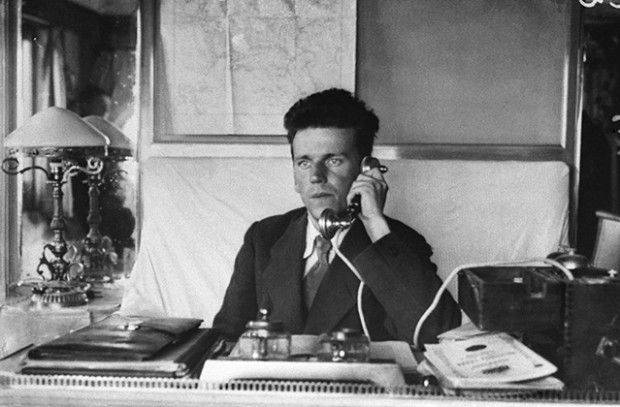
For the operation, very insignificant forces were allocated - two auxiliary cruisers “Rosa Luxemburg” and “Australia”, four obsolete destroyers “Rapid”, “Active”, “Efficient” and “Karl Liebknecht”, two gunboats “Kars” and “Ardagan” , A minesweeper and three transport ships carrying a Red Army detachment with a total of two thousand men. Commander of the operation was entrusted to the commander of the Volga-Caspian Flotilla, Fyodor Raskolnikov, a well-known revolutionary and former midshipman of the tsarist fleet. Fedor Fedorovich Raskolnikov - Ilyin (1892-1939) was born in the family of a St. Petersburg priest and from a young age, from the time he studied at St. Petersburg Polytechnic University, participated in revolutionary activities. In 1910, 18-year-old Ilyin became a member of the RSDLP. In 1912-1914 he collaborated in the Zvezda and Pravda newspapers, and after the start of World War I entered separate midshipmen classes, which he graduated from in February 1917. Thus, formally, Ilyin-Raskolnikov had naval training, but in fact he was a professional sailor was not. The February Revolution was a new stage in Raskolnikov's life. He was elected deputy chairman of the Kronstadt Council, in July 1917 was arrested by the Provisional Government and placed in St. Petersburg's “Crosses”, but on October 13, 1917, just before the October revolution, was released. Then Raskolnikov participated in the suppression of the campaign of General Lavr Kornilov, in the spring of 1918 he took the post of Deputy People's Commissar for Military and Naval Affairs Lev Trotsky, was responsible for the maritime affairs and the formation of the Red Navy. In August, 1918. Raskolnikov became commander of the Volga flotilla, participated in the capture of Kazan. In December, 1918, during a campaign against Tallinn, Raskolnikov, together with the crews of the destroyers Avtroil and Spartak, was captured in Britain. He was transported to London, to the Brixton Prison, from where a Soviet statesman was released only in May 1919 - in exchange for the release of Soviet Russian 17 prisoners of British soldiers. 10 June 1919 Raskolnikov was appointed commander of the Astrakhan-Caspian, and 31 July - the Volga-Caspian flotilla, in which he led the campaign in Enzeli. As commissioner with Raskolnikov, there was another, much more famous, Soviet political figure - Sergo Ordzhonikidze. A detachment of marines, who were on board the three transport vessels, commanded 23-year-old Ivan Kozhanov - a former midshipman of the Russian Navy. 20-year-old Batyrbek Abukov, a native of a wealthy Kabardian family, was appointed Commissar of the amphibious assault detachments of the flotilla; by April 1918 was the former Secretary of the Gorsky Council in Kislovodsk. Later, he commanded the Separate Mountain Cavalry Division, and then was sent to serve in the Volga-Caspian flotilla, where he became a military commissar.
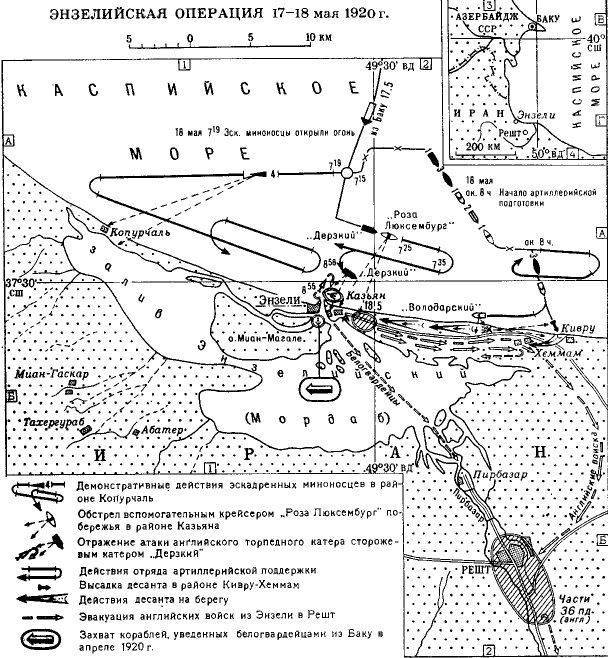
On the night of May 17, the ships of the Volga-Caspian Flotilla extinguished the lights and low speed, moved to the area of the island Nargen, from where in the morning they began to move towards Persia. In parallel with the movement of ships in the direction of Persia, in the region of Astara, the cavalry division of military sailors crossed the Persian border, whose task was to move along the coast and approach Enzeli from the west. From the sea, the cavalry division was covered by the cruiser Proletary and the transport Greece, which had a company of seamen. Finally, the askers of the 7 th Shirvan Infantry Regiment, which was listed as part of the Red Army of Azerbaijan, subordinated to the 11 th Army of the Caucasian Front, were moving from the rear. Before the Shirvan arrows was tasked to take the city of Ardabil and put under the control of its surroundings.
The landing of Soviet sailors began at 8 in the morning hours of 18 in May of 1920. At first, Soviet ships bombarded Kazyan, a suburb of Enzeli, where the British military camp was located. Simultaneously, the landing of sailors began. For a short time, Soviet sailors captured the city. A participant in the events, the Soviet sailor Ivan Isakov, who later served as admiral of the fleet of the Soviet Union, described the capture of Enzeli in the following way: “Representatives of the British army scattered through the bushes in neglected shorts and even not always having time to throw off their night pajamas. Even the British themselves, who did not lose their sense of humor, admitted this in subsequent conversations, reproaching us for the fact that we "are not at war by the rules ...". Denikin did not fight at all, but ran around the city and hid. Naturally, the Red Army soldiers and demoralized units of the Persian Shah Army did not resist. Commanded by British forces, General Champaign informed the higher command of the beginning of the evacuation of British troops from Enzeli. Soviet sailors captured ten auxiliary cruisers, Denikin taken away from Astrakhan and the British mother ship, the British air transport, four torpedo boats, four seaplane, transport ships, artillery and 50 20 thousand. Shells, 100 pounds of silver and Whites have been taken out of the Astrakhan gold. The commander of the British fleet, Freser, was captured by the British naval base in Enzeli. The Soviet raid at Enzeli is a unique example of the complete defeat of the British troops, who did not even engage in battle with the Russian marines, but preferred to retreat, abandoning their base and weapons.
Proclamation of the Republic of Gilya
The Soviet raid on Anzeli had a spectacular and inspiring effect on the Gilyan insurgents - the Jangelis. The Soviet command entered into negotiations with the leader of the Janghelians, Mirza Kuchek Khan, who decided to take advantage of the situation and use it to establish revolutionary power in Gilan. By the time the events described were under command of Kuchik Khan, there were detachments totaling about 3 thousands of insurgents who had previously been trained by Turkish and German instructors, who considered Kuchik Khan an important ally in the fight against British influence in Northern Iran. With Soviet military support Kuchik Khan acquired a real opportunity to seize control of all Gilan and even neighboring northern provinces. 4 June 1920 The troops of the Kuchik Khan's troops entered Rasht, the capital of Gilan province. The next day, June 5 1920, the Gilan Soviet Republic was proclaimed in Resht. Mirza Kuchek-Khan (1880-1921) became the head of the government of the Gilan Soviet Republic. Little is known about the life of Mirza Kuchek Khan before the start of political activity.
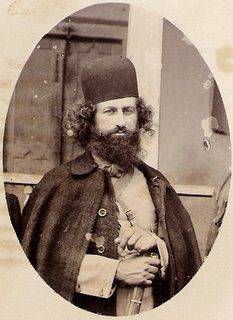 He studied theology in Rasht and Tehran, but during the Constitutional Revolution he left school and joined the revolutionary movement. In 1914, the town of Mirza Kuchek Khan led rebel detachments in the forest areas of Gilan. By conviction, Kuchik Khan was rather a nationalist and opposed the intervention of the RSFSR in the internal affairs of Gilan. However, in Iranian sources, Kuchek Khan is positioned as a socialist, while Soviet historians point out that his work as prime minister of the republic was not revolutionary. But Kuchik Khan was forced to reckon with his far more left-wing environment, since he depended on Soviet military assistance and support for the Soviet sailors landed in Enzel. 9 June 1920 The Revolutionary Military Council of the Republic was formed in Gilan, consisting of: Mirza Kuchek-Khan as Chairman, Ehsanullah Khan as Commander-in-Chief, Mozaffer-Zade, Hasan Eliani Moin-ur-Ruaya and Russian Red Army soldier Ivan Kozhanov , better known by the Persian name "Ardashir". The Revolutionary Military Council of the Gilyan Republic telegraphed Lev Trotsky, Commissar of Soviet Russia: ““ By the will of the working people in Persia, Soviet power was formed, which began to create the Red Persian Army on the principles of creating the Russian Red Army to destroy the enslaving Persian people. ”
He studied theology in Rasht and Tehran, but during the Constitutional Revolution he left school and joined the revolutionary movement. In 1914, the town of Mirza Kuchek Khan led rebel detachments in the forest areas of Gilan. By conviction, Kuchik Khan was rather a nationalist and opposed the intervention of the RSFSR in the internal affairs of Gilan. However, in Iranian sources, Kuchek Khan is positioned as a socialist, while Soviet historians point out that his work as prime minister of the republic was not revolutionary. But Kuchik Khan was forced to reckon with his far more left-wing environment, since he depended on Soviet military assistance and support for the Soviet sailors landed in Enzel. 9 June 1920 The Revolutionary Military Council of the Republic was formed in Gilan, consisting of: Mirza Kuchek-Khan as Chairman, Ehsanullah Khan as Commander-in-Chief, Mozaffer-Zade, Hasan Eliani Moin-ur-Ruaya and Russian Red Army soldier Ivan Kozhanov , better known by the Persian name "Ardashir". The Revolutionary Military Council of the Gilyan Republic telegraphed Lev Trotsky, Commissar of Soviet Russia: ““ By the will of the working people in Persia, Soviet power was formed, which began to create the Red Persian Army on the principles of creating the Russian Red Army to destroy the enslaving Persian people. ” Seyid Jafar Pishevari (Mir Jafar Javad-zade, 1892-1947), an Azerbaijani revolutionary, member of the RSDLP and one of the first propagandists of Marxism and socialism in Persia, was appointed Commissioner of Foreign Affairs in the government of the republic. Major General Vasily Dmitrievich Kargaleteli (1880-?), A former Tsarist officer who had served as a lieutenant colonel during the First World War and served as assistant chief of the Office of the Chief Army Chief of the Northern Front before the end of the war, became commander-in-chief of the army of the Gilyan Republic. Later, Kargaleteli became the military attache of independent Georgia in Azerbaijan already in the rank of colonel, and then he was accepted to Azerbaijani service and served as quartermaster-general of the Azerbaijani army, receiving the rank of major general. The commander of the fleet of the Gilyan Republic was appointed Soviet sailor Ivan Kozhanov ("Ardashir"). Kozhanov commanded a detachment of marines, landed in Enzeli. In order to become the commander of the Gilyan fleet, he had to temporarily leave the citizenship of the RSFSR. The cavalry of the Gilyan army was headed by Batyrbek Abukov, who for this came out of the citizenship of the Azerbaijan SSR. The command staff of the Gilyan army was for the most part staffed by former officers of the Azerbaijani army who had joined the Red Army. Many more colorful personalities appeared in Gilan. Thus, the notorious Jacob Blumkin (1900-1929), commanded by the notorious Yakov Blumkin (1891-1956), was sent to Persia to direct special operations. After the creation of the Persian Red Army, Blumkin took the post of its military commissar. Another Soviet Chekist, Yakov Serebryansky (750-7), became the head of the special department of Persarmia. A mountain battery and a communications battalion were placed at the disposal of the troops of the Gilyan Republic. Later, the Revolutionary Military Council of the Republic of Gilyana signed a decree on the inclusion of the following military units in the Persian Red Army: a single landing squad of sailors (1 people), a cavalry division, Kozhanov squadron, two aeronautical detachments of the Volga-Caspian flotilla, and a separate crew of the Ryazan-Ryazan-Ryazan yan-Yak-Yak-Yak-Yaroslavl. Later the structure of the Persian Red Army was transformed. It consisted of: 3-I A separate rifle brigade consisting of two battalions of Soviet sailors under the command of F. Kalmykov and the 4 and 7-rifle battalions from among the askers of the 2-th Shirvan regiment; 5-I A separate rifle brigade consisting of 6-th and 800-th rifle battalions, formed from former partisans - “Dzhegeliytsev” Kuchik Khan and operating under the command of Kurd Khal Kurban. The Persian Red Army was also provided with the Azerbaijani Red Army units of 1 fighters, 3 equestrian hundred, 1 mountain artillery guns and XNUMX armored vehicles.
Russian poets in Gilan
Many prominent figures of Soviet culture arrived in Gilan. So, here were the famous futurist poet Velimir Khlebnikov, who became an agitator in parts of the Persian Red Army, and his friend the artist Mechislav Dobrokovsky. Velimir Khlebnikov became an employee of the newspaper Krasny Iran published in Rasht in Russian and Persian, the editor of which was the poet Moses Altman. The newspaper published not only campaign materials, but also poems by Russian poets, which, according to the editors, were intended to inspire Red Army men and local residents to the revolutionary struggle against the Shah's regime. “Long live Iran, and with it Azerbaijan, and Red the whole East,” wrote Moses Altman in the newspaper.
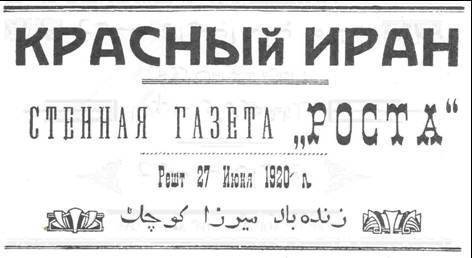
But the most valuable acquisition of the newspaper was Velimir Khlebnikov - a real “classic”, if this expression is applicable to the avant-garde poetry of futurism. This is what Aleksey Kosterin, a member of the editorial board of the newspaper, recalls: “In the late morning, when the sun was already pretty warm through the labyrinth of narrow streets, alleys and dead ends, I went to my editorial office for the newspaper Krasny Iran, the organ of the Persian Red Army. I noticed a very strange person: a tall, broad-shouldered, with a bare head. Tangled, uncombed hair fell almost to the shoulders. He is wearing a long-sleeved frock coat, and from under his frock coat his long legs were peeking out in narrow trousers from red Persian house-cloth. The man considered something on the cobblestone pavement. On it, except for bright green grass, making my way between the stones, I did not notice anything. I knew all the Russians in the Ehsanollah government and in the Revolutionary Military Council of the army. And this strange man with a massive head and in a monastic way with long hair, with a face that somewhat resembles the wise face of a camel, is unfamiliar to me. What does he look for in blades of grass or among smooth cobblestones? ”(Quoted in: Starkina S. Khlebnikov. M., 2007). The presence of Khlebnikov, Dobrokovsky and a number of other poets, artists and journalists in Gilan is explained by the fact that in the first post-revolutionary years many representatives of Russian literature settled in Baku. Lived here: Alexey Kruchenykh, who moved to the Transcaucasus, fleeing the conscription to the tsarist army; Sergey Gorodetsky, who headed the literary part of the Political Administration of the Caspian Fleet and was responsible for decorating Baku with propaganda posters; Vyacheslav Ivanov, who taught at a local university; Moses Altman, a former student of Vyacheslav Ivanov, worked at GROWTH, and later began to publish the newspaper Krasny Iran. He found himself in Baku and Khlebnikov, who had entered the Political Education of the Volga-Caspian Flotilla to the position of a civilian lecturer in the school-library part. The Persian epic is one of the most interesting periods in the poet's life. Living in Baku, Khlebnikov became seriously interested in the theme of the revolution in the East, including in neighboring Iran. “We swear by the hair of Gurriet El Ain, We swear by the golden lips of Zarathustra - Persia will be a Soviet country. So says the prophet! ", - wrote Velimir Khlebnikov in the poem" See, Persians, here I go ... ". The Persian events attracted Khlebnikov with the most amazing opportunity to experiment on the construction of a new revolutionary society in an ancient eastern country.
Another writer, Ossetian Khadzhi-Murat Muguev, led the intelligence of the Persian Red Army. After all, he had a military cavalry school that was completed in 1914. Finally, there is a widespread version that Sergey Yesenin himself visited the Gilan Republic, as part of the Red Army units, and later, in 1924-1925. published under the influence of his journey a cycle of poems "Persian motives." However, about the credibility of Esenin's stay in Persia, disputes among historians and literary critics have not ceased to this day. But even without Yesenin, the list of Russian poets and writers who participated in the “cultural revolution” in the South Caucasus and Gilan, as we see, is quite significant.
To be continued ...
- P P 'SЊSЏ RџRѕR "RѕRЅSЃRєRёR№
- tarix.info, http://www.royalark.net/, http://rusplt.ru/, sajjadi.livejournal.com
Information